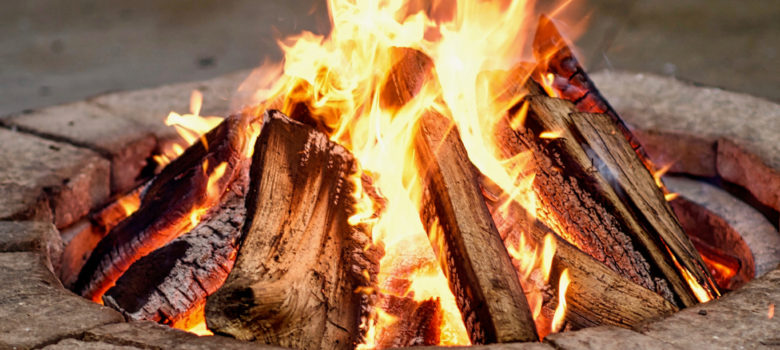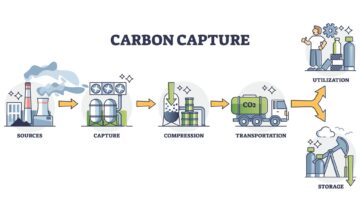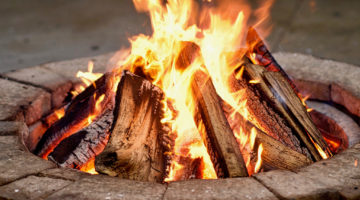
As summer approaches, most people are enjoying spending more time outdoors. While many of us dream of an alfresco dinner, we are often let down by good old British weather. A run of warm weather can quickly be replaced by a snap of unseasonably cold weather even in the middle of the summer. While many people at this point will give up the idea of sitting outside, more and more households are turning to outside firepits and heaters to provide the extra warmth to allow them to battle the colder weather.
In this article we are taking a look specifically at fire pits; what they are as well as the impact they can have on the environment and your health.
What is a firepit?
Essentially a firepit is a controlled open fire, typically using wood as a fuel source. There are lots of different types of fire pit, but the principal is the same – once alight, they provide a nice source of heat to those in the immediate area. In some cases a grill can be added to a firepit allowing you to use it for outdoor cooking – essentially a rustic BBQ!
While firepits provide a nice source of heat and also can look really nice, there are a few common issues associated with them – firstly they are a potential fire hazard, especially if left unattended. As firepits are normally open, they are also a risk for children who may be playing in the nearby vicinity. The final issue relates to the pollution – burning wood as a fuel can have a big impact on the air in the surrounding area.
Why are fire pits bad for the environment and your health?
When burning wood in a fire pit, it is constantly releasing smoke into the air surrounding it. Smoke contains many harmful elements including carbon dioxide, carbon monoxide and methane. These pollute the air that you breathe, and damage any trees or vegetation nearby. They are also all greenhouse gases which are a main factor of climate change.
In populated areas like London, the use of fire pits can actually be reported as a nuisance. The government has decided this as smoke can cause serious impacts to the environment and health of residents in the area. Gardens are situated closer together than in the countryside, meaning fire pits are more likely to affect neighbours and passers by.
Many respiratory problems are associated with inhaling smoke and pollutants, and it can affect your overall immunity and existing health conditions. Smoke is particularly dangerous to children’s health as they are still in development and breathe in a larger amount of air than adults.
How to make your firepit environmentally friendly
Your fire pit is never going to be completely environmentally friendly, as there is no way you can prevent it from emitting smoke, however we would always recommend buying low emission firewood.
Typically the best type of wood to burn is seasoned wood – that is wood that has been allowed to dry out so the moisture content is below 20%. Provided wood is stored in a dry place, over time the moisture will evaporate – this is the process of seasoning.
It is possible to buy kiln dried wood – this is essentially where the natural drying process has been sped up by the use of large industrial kilns.
Burning seasoned wood in the firepit is really important for two reasons – firstly dry wood burns hotter, so the firepit provides more heat. But secondly and potentially more importantly, wet wood (normally any wood with over 20% moisture content) produces more smoke when burnt as the moisture causes incomplete combustion.
If you have a firepit and don’t have access to a log store (where fresh logs can dry out) we recommend looking for kiln dried wood as it will arrive at your home ready to burn. The most environmentally friendly firewood on the market is kiln dried hickory, or kiln dried oak. Although these are not found in most shops, they can be bought online.
Alternative outdoor heaters to fire pits
Apart from fire pits, you can also heat your garden with infrared heaters and gas patio heaters. Electric heaters will obviously not produce any local pollution (although require electricity that may be produced by unclean means – i.e burning gas / coal) – so if you are looking for the most environmentally responsible method of surviving the cold British summer we would recommend this is potentially the way to go – although you won’t be getting the same campfire experience, but you may well feel less guilty about the environment!
In conclusion
Your love of spending evenings outside shouldn’t have to stop because of the environmental issues related to using a firepit. However, if you do use one, always go for seasoned wood with a low moisture content so the fire burns hotter and cleaner.
If you aren’t too bothered about the open fire look, then an electric heater will also do the job and have the added benefit of normally being safer if you kids around as the heating elements are normally quite high!
If you feel that you can fight the cold by throwing on some extra clothing then even better – this is the only completely non polluting method of staying warm in the cold!












Surely a renewable source like wood is preferable to an electric heater which run of electricity generated by a mix of fuels including fossils fuels and nuclear? I get it about pollutants,, but in terms of C02 is an electric heater really greener?
Buring wood is bad for lung health and the environment. Burning wood kills trees and pumps carbon into the air in the form of smoke that would not be there otherwise. People in the local area then have to breathe in the smoke without choice. Log burners cause the same smoke problem. There is nothing eco about burning wood of any type. It is adding to global warming and the extreme weather we all hate. Fire pits just aren’t worth it. Please don’t have one.
If the electric heater is solar-powered then yes.
It is not so much about CO2 as climate change biut about pollution impacting the health of the user and of the people surrounding the user in close proximity. The main particles causing the health issues and according to most research more toxic than smoking tobacco are the 2.5 micron particles.
Have you seen our new The Crop Candle Fire pit we call El Fuego the large flame is produced from Natural Vegatable wax and has practiaclly no Smoke and last 8 hrs? they produce 0.37kg carbon/hr how does that relate to wood or Propain?
I have just come back from camping at an ‘eco-friendly’ campsite in the North Norfolk Coast.there were 5-6 firepits over quite a large area. As well as a few open barbecues. Instead of breathing any fresh seaside air, all I could smell was wood smoke. Not helped by clouds of smoke from one of the barbecues where the owner obviously had no idea how to use it – not an unusual occurrence. This gave me a really serious cough that lasted right through the next day. The children there were also surrounded by the smoke. Firepits and barbecues emitting harmful carcinogenic particles promoted as ‘eco-friendly’ need to be stopped. For people with asthma and heart issues they are particularly dangerous.and completely unnecessary.
Hi, I just came across your article. I know this could seem like a sales pitch but hear me out. The company I work for, Eco Fuego, has a patented formula that creates 90% less CO2 than burning wood or coal. It has the same great flame and heat but doesn’t bring the guilt with it. Our Vegetable Wax Candles burn for 8 hours, in one go or 30 mins at a time. They light in seconds, and extinguish in less than that. Not only is there no smoke and bonfire smell, there are ZERO embers to accidently set the garden on fire with. Have a look for yourselves http://www.ecofuego.com and you will decide that this is the best and more eco-friendly way to enjoy a firepit. So see, there is an alternative to wood, coal and electricity. It’s a candle.